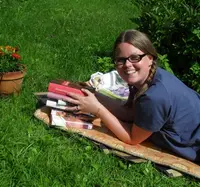Since February 2025, I have been studying at Ahlman on the course for self-sufficient-aiming food producers, which consists of several modules from the gardener’s degree that are relevant for effective homescale vegetable cultivation. As part of my studies, I carried out a practical demonstration project focusing on growing broccoli and, more broadly, open-field brassica production.
As part of the project, I designed and established a small cabbage patch, about one-third of which was dedicated to broccoli. The rest was planted with savoy cabbage, kale, and kohlrabi. Another requirement was to use climate-responsible methods and to share those practices with others. Here are some reflections from the growing season.
At Beyond Buckthorns, we have long made (permacultural) choices that support a smaller carbon footprint: no machines, no synthetic fertilizers, no long transport chains. But when I examined my own growing project through the lens of climate responsibility, it was a good moment to pause and look at what that actually means in practice.
What did I do differently?
Fertilization was done with compost, chicken manure bedding, and nettle tea – all based on recycled materials. The production of industrial fertilizers still relies heavily on fossil energy. Nitrogen fertilizers are made using the Haber–Bosch process, in which atmospheric nitrogen is converted into ammonia, using natural gas as both a hydrogen source and a heat source. This process consumes vast amounts of energy and produces significant CO₂ emissions – estimated at 1–2% of global energy use (Tunley Environmental, IEA).
Phosphorus, on the other hand, is an essential nutrient for plant growth that cannot be replaced by any other substance. Unlike nitrogen, phosphorus cannot be fixed from the air – it must be mined, and global reserves are finite. Most of the world’s phosphorus comes from just a few countries (such as Morocco), making its availability geopolitically sensitive. Mining, refining, and transporting phosphorus consumes fossil fuels and causes greenhouse gas emissions (UNEP).
For this reason, using organic and recycled nutrients – such as compost and chicken manure – significantly reduces the fossil footprint of cultivation and makes nutrient cycling more local.
Irrigation was mostly done by hand using stored rainwater. A pump was used only to transfer water from one IBC tank to another when gravity alone wasn’t sufficient.
Farming with minimal fuel use: The entire process, from seedling raising to harvest, was done by hand, except for trimming the pathways with a battery-powered trimmer. I tried to charge the battery on sunny days when our solar panels produced more energy than we could use (the surplus is fed into the grid for others to use). I mowed the garden edges with a petrol lawnmower – so, not entirely fossil-free, but close.
Mulching: Organic mulch reduced the need for irrigation and kept the soil life active and healthy.
Even though the scale of this project is small, and its climate impact won’t change the world, our choices still matter. When every grower – even a small one – thinks about how to do things more wisely, the effect multiplies.
Adaptation and solutions
In my cultivation plan, I tried to take into account the effects of climate change on growing conditions, such as extreme weather and the increase of pests. The cabbage bed was protected with a mesh cover that kept pests away mechanically, without chemical pesticides. A diverse selection of varieties and companion plants (such as dill, borage, nasturtium, and marigold) supported biodiversity and plant health.
At the same time, I learned that moderation is key – at one point, the cabbage patch turned into more of a nasturtium patch, and the cabbage yield remained rather modest in the end.
During seedling production, I noticed that light levels were insufficient for proper growth. This led me to prefer direct sowing in future – both to reduce climate impacts (less energy use for grow lights, even though they were LEDs) and to improve success in practice.
Economy and feasibility
The methods used are economically realistic for home-scale cultivation. For commercial production, other solutions would be needed. In general, a major shift in societal attitudes would be required regarding what is truly important and what counts as essential work before such methods could be applied on a large scale.
For hobbyists and home gardeners, I hope that at least everyone will stop buying synthetic fertilizers and instead aim to close the nutrient cycle within their own garden. In Finland, composting is an excellent method for this. Recycled fertilizers are affordable or even free (thanks to generous neighbors!), and hand-based cultivation requires no major investments.
However, these methods do require time and a bit of know-how, as I also discovered over the course of the year. My studies may end here for now, but the learning journey continues.







